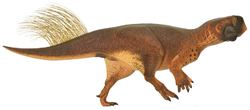| Crittendenceratops Temporal range: Campanian, | |
|---|---|
 | |
| Life reconstruction of C. krzyzanowskii | |
| Scientific classification | |
| Kingdom: | Animalia |
| Phylum: | Chordata |
| Class: | Reptilia |
| Clade: | Dinosauria |
| Clade: | † Ornithischia |
| Clade: | † Ceratopsia |
| Family: | † Ceratopsidae |
| Subfamily: | † Centrosaurinae |
| Tribe: | † Nasutoceratopsini |
| Genus: | † Crittendenceratops Dalman et al., 2018 |
| Species: | †C. krzyzanowskii |
| Binomial name | |
| †Crittendenceratops krzyzanowskii Dalman et al., 2018 | |
Crittendenceratops (meaning "horned face from the Fort Crittenden Formation") is a genus of horned centrosaurine ceratopsid dinosaur from the late Campanian Fort Crittenden Formation of Arizona. It contains a single species, C. krzyzanowskii, and represents the first dinosaur taxon from that formation to receive a formal scientific name.




